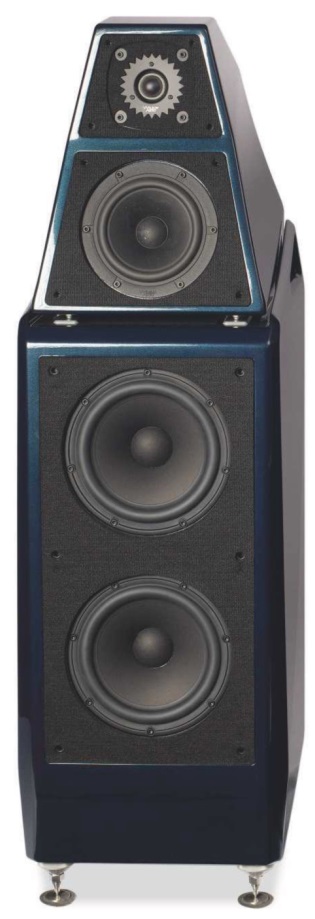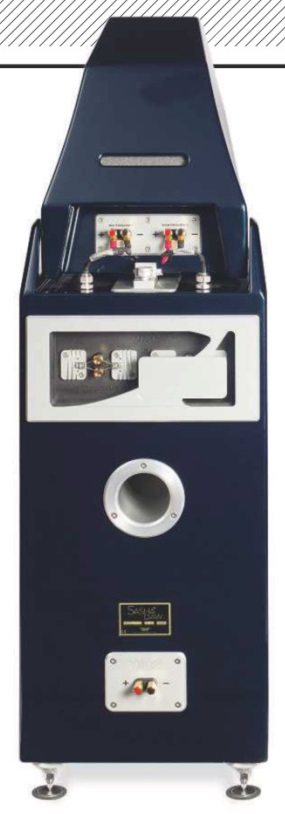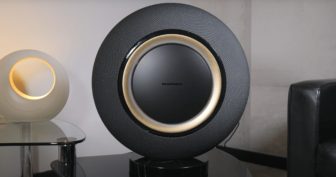Wilson Audio Sasha DAW Review
Launched to celebrate the life’s work of Wilson Audio’s founder, this new Sasha is no mere mk3 Review: Jose Vitor Henriques, Lab: Keith Howard
Three-way floorstanding loudspeaker Made by: Wilson Audio Specialties, Utah, USA Supplied by: Absolute Sounds Ltd Telephone: 0208 971 3909 Web: www.wilsonaudio.com; www.absolutesounds.com
Contents
The Sasha DAW is a tribute product launched by Daryl Wilson to honour his recently deceased father and Wilson Audio’s founder, David Andrew Wilson, whose initials denote the latest form of this iconic loudspeaker [see boxout, p43]. In practice, the Sasha DAW has the same form factor and three-way, four drive configuration as the Sasha Series-2 [HFN Jun ’14].

RIGHT: Claiming no shared parts with the Sasha S2, the DAW’S 8in woofer and 7in mid units are derived from the Alexia 2. Cabinet volumes are increased, bracing improved and the woofer baffle tilted back by 3°
Its dimensions are also roughly the same at 114x37x58cm (hwd), comprising a bass cabinet and separate mid/treble head enclosure, the latter exquisitely adjustable via a series of alloy steps built into the top of the big box. So while it’s even easier to focus the DAW in on the listening position, it’s also gained some 10kg in weight thanks to the extended use of Wilson’s X-material in its construction.
TRICKLEDOWN TREATMENT
It’s tempting to think of the Sasha DAW as a scaled-down Alexia S2 [HFN Mar ’18] but at a fraction of the cost – here in its standard colours of Diamond black. Dark titanium, and Argento or Desert silver – than a potential Sasha Series 3 wannabe. The long list of features inherited from its bigger sister begins with the bass cabinet, for the enclosure now has additional bracing, a cut-out in its floor to accommodate the crossover and the baffle tapered by 3° for improved time alignment.
To gain internal volume, both the woofer and midrange/tweeter cabinets have had their interconnecting wire chambers removed, the cables now reaching out through gas-tight holes. Even the midrange driver and the
‘They enthrall in the way they nail the urgency of rhythms’
Wilson ‘Synergy mk5’ tweeter are borrowed from the Alexia S2, these previously inherited from the WAMM. There’s more trickledown in the woofer drivers, which are said to offer a flatter, more linear bass response, and are ‘based on the 8in driver found in the Alexia S2, redesigned by [Director of Engineering] Vern Credille for the specific needs of the Sasha’.
FINE TUTORING
Around the back, the port has been relocated to the centre of the cabinet and remoulded for lower turbulence while the mid/treble resistor plate lies behind the integrated, and easily removable, tempered- glass window first seen in the Alexx. There’s clearly a family ethos at work here: Wilson’s youngest not only wear the finest ‘shoes’ and ‘clothes’ of their eldest but also get the same ‘education’!
The Sasha DAW also has new and very heavy duty binding posts, redesigned by Daryl Wilson and lead mechanical engineer Blake Schmutz. These are easier to tighten by hand and now include a 4mm banana plug option. Other revisions include the visually appealing cut-outs on top of the woofer cabinet designed ‘to reduce cavity pressure in the space between the upper and lower modules’, and these are also very useful as peeping- holes to the time alignment block steps. ‘The user interface of the group-delay mechanism now features a knurled knob, enabling the adjustment to be facilitated without tools’, or so they say, as it’s still not easy to unscrew by hand once you tighten it up.
As usual, the Sasha DAW comes in a rainbow of colours beyond the ‘standards’, with 5% added to the price for specials including Obsidian black, Oxford grey, Ghilles green, Imola red, Bugatti blue, Biarritz white and Fly yellow. Any off-the-books, RAL colour-matched, request will attract a 10% supplement.
STEP BY STEP
I began with the speakers set up in a large room on the very same spot the Alexia S2s had sung their hearts out in the HFN May ’18 review. Despite the technical similarities, the Sasha DAW’s bass was tighter and leaner than that of the Alexia S2, but wasn’t as deep. This was to be expected considering the difference in size of the speakers’ bass cabinets, so I surmised the Sasha DAW would feel more at ease in a more intimate environment.

I then moved them to a smaller room, measuring 6x5m. Here they responded best when roughly 1.2m from the front and side walls, 2.8m apart, toed-in albeit not pointed straight at the sweet spot and located some 3.5m away from the listening seat. Electronics comprised the Dan D’Agostino Momentum Integrated amp [HFN Dec ’14], Audio Research REF160M valve amplifiers [HFN Aug ’18], and the Audio Research REF CD9 CD player as source [HFN May ’13].
After much experimentation with the time alignment system I found that Step 5 on the adjustment ladder gave the best compromise – one small step for Sasha DAW, one giant leap for sound quality. There only remained the matter of treble purity.
While this was slowly improving as the test proceeded, I was wondering if the Sasha DAW was suffering from the same mild low treble resonance that afflicted the Alexia S2. It was at this point that the local distributor recommended that the system be fully cabled with Transparent Opus II.
Now, the mere suggestion that you need to invest as much in cables as you do in loudspeakers will sound preposterous to some. And yet the Opus II brought the miracle I had been seeking. The Sasha DAWs were now singing like girls in the giddy first days of marital bliss.
KING OF THE RING
Isabelle Faust is one of my favourite violinists. She joined Alexander Melnikov to deliver Mozart Sonatas For Fortepiano & Violin, Vol. 1 [Harmonia Mundi HMM 90 2360] using period instruments. Recorded in a studio with a small-hall ambience, both fortepiano and violin sounded superb through the Sasha DAW. The former is all about glittering fundamentals and it rang clean like a bell, with some appropriate heft and roar from the left hand. Meanwhile, the violin’s dynamic and tonal range were conveyed fully.
Mozart’s sonatas are the closest thing to jazz, having a degree of improvisation and conversation between the instruments. The Sasha DAW delivered all the ‘humour and rhetoric’ therein – as Isabelle Faust herself would put it in when interviewed for the Violin Channel.
Portuguese Fado music is all about fate and overpowering emotions.
‘Os Buzios’, sung by Ana Moura from the album Para Alem Da Saudade [Universal 06025 17338982] tells the story of a young woman who seeks help from an old witch who casts winkles (buzios) in an effort to divine
A NEW DAWN
If our reviews carried titles then ‘Sasha, a new DAW(n)’ would be apt because this speaker is not simply another Sasha iteration following on from the Sasha Series-2 [HFN Jun ’14], which in turn carried the DNA of the original two-box Watt/Puppy. I will always feel privileged to have been in Munich back in 2009 when the original Sasha was unveiled for the first time. Alas, it was the last occasion on which I was able to interview Dave Wilson. But I still remember how happy he was for what he considered to be a turning point in Wilson Audio’s history. At the time, I wrote: ‘The saga is not over yet. This is a never ending story of passion and commitment to the quest for the Holy Grail and I hereby pledge not to retire until I review the Sasha V‘. It may be a close call!
the young woman’s fortune in love. Any fine loudspeaker will allow you to enjoy Moura’s sensual artistry.
But it takes a Sasha DAW to feel empathy with the pathos and hope of the song’s main character.
At Last [Blue Note CDP 7 91937 2] is my favourite Lou Rawls CD. It has it all: soul, R&B, blues and jazz from an all-star lineup that includes Ray Charles and George Benson – with their characteristic throaty voices – and Dianne Reeves who soars along without compression or limitation in ‘At Last’ and ‘Fine Brown Frame’, if somewhat enveloped in mild electronic reverb. Yet that’s the nature of the recording itself.
The Sasha DAW simply gives you the truth. Some of the up-tempo tracks, such as ‘You Can’t Go Home No More’ and ‘Room With A View’ are propelled by Tinker Barfield’s bass and Chris Parker’s drums and the speakers nailed the rhythmic urgency in a manner that enthralled

LEFT: Reflex bass enclosure vents via a rear-firing port, as does the midrange via a tuned slot in the upper module. Back plate reveals resistors for level matching the midrange driver and tweeter
with its pace while saxophones, trumpet, trombone and flugelhorn flourished with their respective timbres perfectly portrayed.
Marcus Miller’s soundtrack to the movie Marshall [Warner Bros; HDtracks download], offers 28 songs including jazz-style classics from the ’40s and more up-to-date gems, featuring Jimmy Heath, Wynton Marsalis and Andra Day (the Sasha DAW truly shows off her pipes as she sings the Oscar Best Song Nominee ‘Standing Up For Something’).
DREAM TEAM
However, the piece de resistance is Jussie Smollet’s breathtaking reading of Langston Hughes’ 1935 poem Let America Be America Again – a poignant portrayal of black life in the US that recalls the Founding Fathers’ dream of liberty and equality for all. ‘Let it be the dream it used to be’.
Just listen to this piece through a pair of Sasha DAW speakers and you’ll realise this is ‘the dream the dreamers dreamed’, to borrow Langston Hughes’ own words, for Daryl Wilson has managed to fulfil the dream his late father dreamed.
True, there’s a splash of natural sibilance here and there, due to close miking, but you can feel the weight and emotion of each and every word in Smollet’s recital, ornamented by the lyricism of a piano and the unsettling skittering of brushes on snare. Seldom is passion so intense.
VERDICT
LAB REPORT
WILSON SASHA DAW
Specified sensitivity has dropped 1 dB to 91 dB for the Sasha DAW compared to the previous Series-2 [HFN Jun ’14], but our pink noise figure of exactly 90dB SPL at 1 m for 2.83V input indicates that the reduced figure is still a little optimistic. This figure was obtained by measuring at 3m and correcting to 1m, though: had the measurement actually been made at 1 m the result might have been a little different. Good news: the DAW is easier to drive than the S2. albeit still challenging. The impedance minimum is a little higher at 2.4ohm and the impedance phase angles no worse, so the minimum EPDR rises from 1.1 ohm at 72Hz to 1.3ohm at 67Hz, with a second dip to 1.7ohm at 120Hz. Make no mistake, though: the Sasha DAW demands a partnering amplifier happy to drive low impedances.
Forward frequency responses [Graph 1, below] were measured at a mic height of 40in with the Sasha DAW set up for this listening height and 10ft (3.05m) listening distance. Ignore the decline in output below 600Hz which is an artefact of the necessarily short measurement time window. Apart from a marked dip in output in the octave between 2-4kHz, the trend is flat prior to a narrow peaking just below 20kHz. The response errors between 500Hz-20kHz are lower than the S2’s at ±2.8dB and ±3.7dB. respectively, and although pair matching over the same frequency range is a little disappointing at ±1.3dB it reduces to a creditable ±0.7dB below 18kHz. Diffraction- corrected nearfield measurement showed bass extension to be 38Hz (-6dB re. 200Hz) – an improvement over the S2’s 49Hz. Resolution of the CSD waterfall [Graph 2] is poor because of the short time window but a few treble resonances are visible.

ABOVE: The Sasha DAW’S forward response is flat in trend, albeit with a hint of a recessed presence band

ABOVE: Cabinet resonances are very well-damped while driver modes are limited and only at 5kHz+
Specifications







